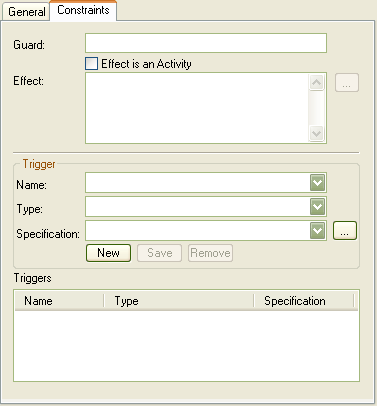
A Transition defines the logical movement from one State to another, in a State Machine diagram. The Transition can be controlled through the following connector Properties dialog:

Field/Button |
Description |
Guard |
An expression that is evaluated after an Event is dispatched, but before the corresponding Transition is triggered. If the guard is true at that time, the Transition is enabled; otherwise, it is disabled. |
Effect is an Activity |
Specifies that the effect is an activity. |
Effect |
Specifies an optional activity to be performed during the Transition. |
Trigger |
|
Name |
The name of the trigger. |
Type |
The type of trigger: Call, Change, Signal or Time. |
Specification |
Specifies the event instigating the Transition. |
New |
Creates a new trigger. |
Save |
Saves the current trigger. |
Remove |
Removes the selected trigger from the list. |
Triggers |
Lists the current triggers for the Transition. |
Note: Fork and Join segments can have neither triggers nor guards.
Toolbar Icon
![]()
OMG UML Specification
The OMG UML specification (UML Superstructure Specification, v2.0, p. 17) states:
"A relationship between two states indicating that an object in the first state will perform certain specified actions and enter the second state when a specified event occurs and specified conditions are satisfied. On such a change of state, the transition is said to fire."


